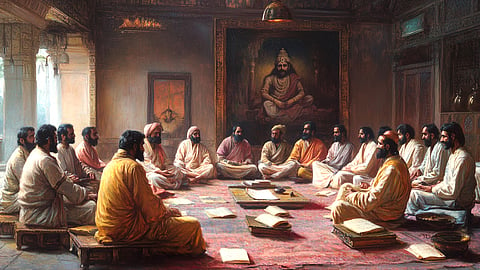- Commentary
- History Vignettes
- Notes on Culture
- Dispatches
- Podcasts
- Indian LanguagesIndian Languages
- Support

A LAMENTABLE DEVELOPMENT in Indian history writing during recent years is the near total absence of utilising primary texts written in Sanskrit. To state the obvious, this outcome is the singlehanded work of the Nehruvian - Marxist cabal’s targetted destruction of Sanskrit both as a language and as the foundation of Bharatiya Culture.
Primary sources of Indian history written in Sanskrit cannot be strictly categorised as formal or official historical documents in the sense we understand the term. Neither were they meant to be formal histories. In both conception and execution, they are, primarily, works of exquisite poetry infused with real historical events and personages.
They stemmed from a very ancient tradition of narrative literature where the emphasis was on ideals and values reflected through the lives and deeds of heroic and noble people. Imagination, creativity, exaggeration and the use of various literary devices heightened the primacy of these values and ideals. The outlook towards history of these poets was vastly different.
Which is why, barring perhaps Rajatarangini, the Western historical method rejects almost the whole corpus of Sanskrit primary sources including the various Charitas or biographies. Notable Charitas include the Harshacharita, kumārapālacarita, etc. Others in this class include the renowned hammīra mahākāvya. These works contain valuable historical information not only about the protagonist of the work but the socio-political conditions of the period.
By a careful study of all such works, it is possible to reconstruct a first hand history of both events and people. In fact, this endeavour had begun in earnest about 120 years ago and had a glorious run until the Marxists pounded it almost to extinction.
In the essay series celebrating the distinguished life and legacy of Sri P.K. Gode published on The Dharma Dispatch, we had narrated how he toiled for decades at the Bhandarkar Oriental Research Institute to collect, collate and organise rare and precious Sanskrit manuscripts. Other universities and private bodies of that era were engaged in similar efforts.
How easily we forget that complacency and negligence breeds amnesia. Thus, it might surprise most of the educated public that even as recently as the 1940s, the Mysore Wodeyars had continued to nurture the composition of Sanskrit works based on historical themes.
And the neighbouring Maratha Empire, starting with Chhatrapati Shivaji had an equally glorious tradition in this literary realm. In fact, there is a wealthy corpus of Sanskrit works that give us vividly detailed pictures of life in the Maratha Empire. Eminent historical scholars such as G.S. Sardesai, Jadunath Sarkar, P.V. Kane, Rajwade, and D.V. Potdar have made fine use of this source material in their own works.
While it is impossible to give a full catalogue of these Sanskrit works here, a partial list will suffice to underscore their inestimable value as well as provide a sample of their contents.
1. Śivabhārata - Authored by Paramananda, this work narrates the heroic exploits of Chhatrapati Shivaji in 31 chapters in the form of a dialogue.
2. parṇālaparvata grahaṇākhyāna - This narrative poem composed by Jayarama in five ullāsas (sections) describes the capture of the Panhala fort (near Kolhapur) by Shivaji.
3. Rājārāma-carita - This is a quasi biography of Shivaji’s son, Rajarama in five cantos, authored by his Raja-Purohita, Keshava Pandita. It is notable for its graphic and elaborate description of Rajaram’s life-and-death struggle in Karnataka against the asuric forces of Aurangzeb.
4. Śaṃbhurāja-carita - Authored by Hari Kavi, it is a biography of Sambhaji, Shivaji’s son and successor. Hari Kavi was a talented poet who lived in Surat, which Shivaji had wrested from the Mughals a few decades ago. The work was commissioned by Sambhaji’s minister, “Kavi-kalaśa” Krishna Pandita.
5. Rādhāmādhavavilāsa-campū - Authored by Jayarama, this literary work belonging to the campū (mix of prose and poetry) category describes the well-known story of Radha and Krishna. What makes it historically significant is its description of Sahaji Bhosle’s court life.
6. śivakāvya - An important work, it narrates the history of the Maratha Empire from Chhatrapati Shivaji all the way up to the abdication of Baji Rao II. Its author, Purushottam Bandeshti lived in Pedgaon, Ahmednagar and outlived Baji Rao by about five years.
7. Alaṅkāra-mañjūṣā - This is a technical work on Sanskrit poetics authored by Devashankara. Its historical importance lies in the manner in which the poet brings out the character and personalities of Peshwa Madhava Rao and his uncle Raghunatha Rao.
We hope you found this list useful.
The Dharma Dispatch is now available on Telegram! For original and insightful narratives on Indian Culture and History, subscribe to us on Telegram.
